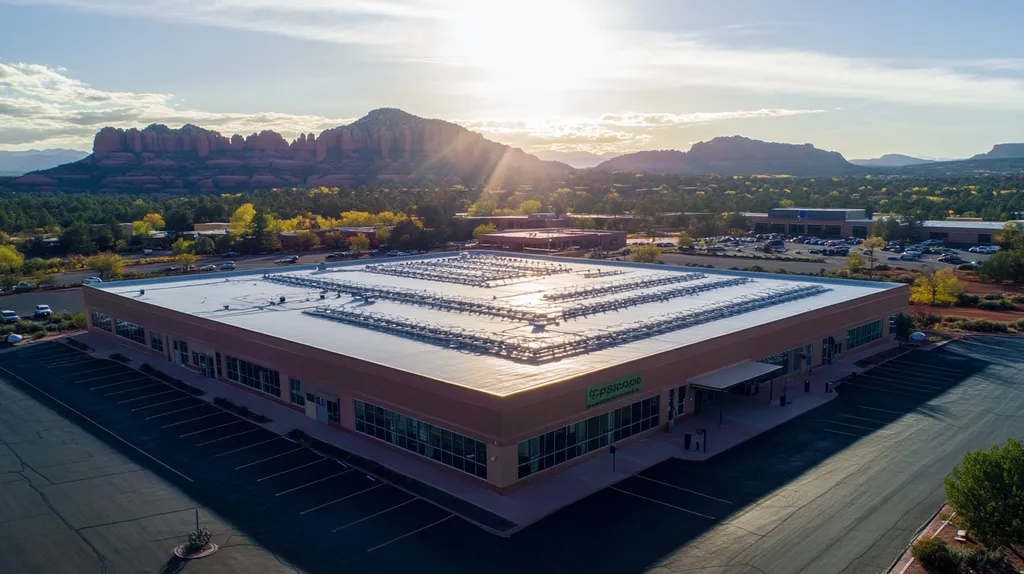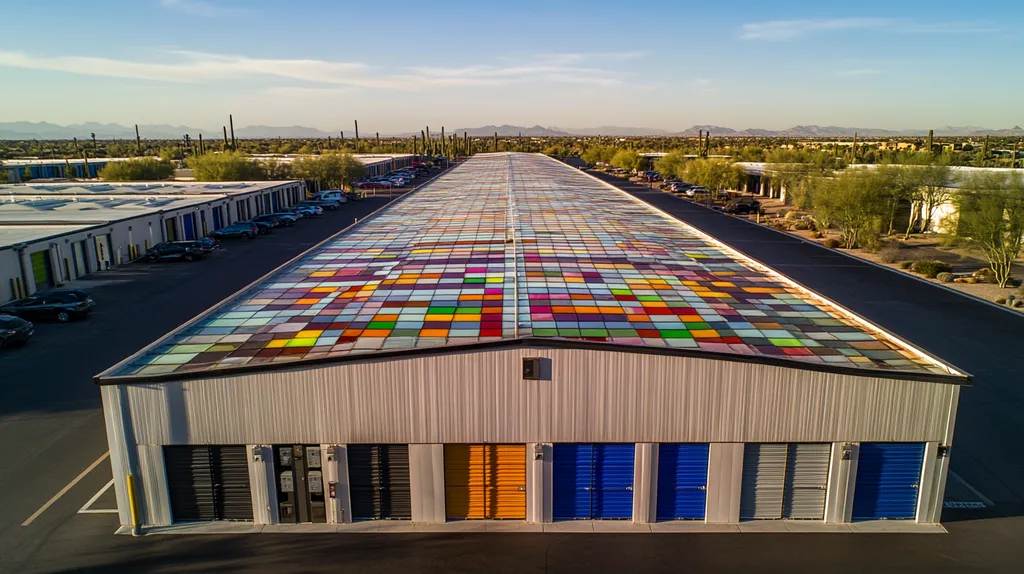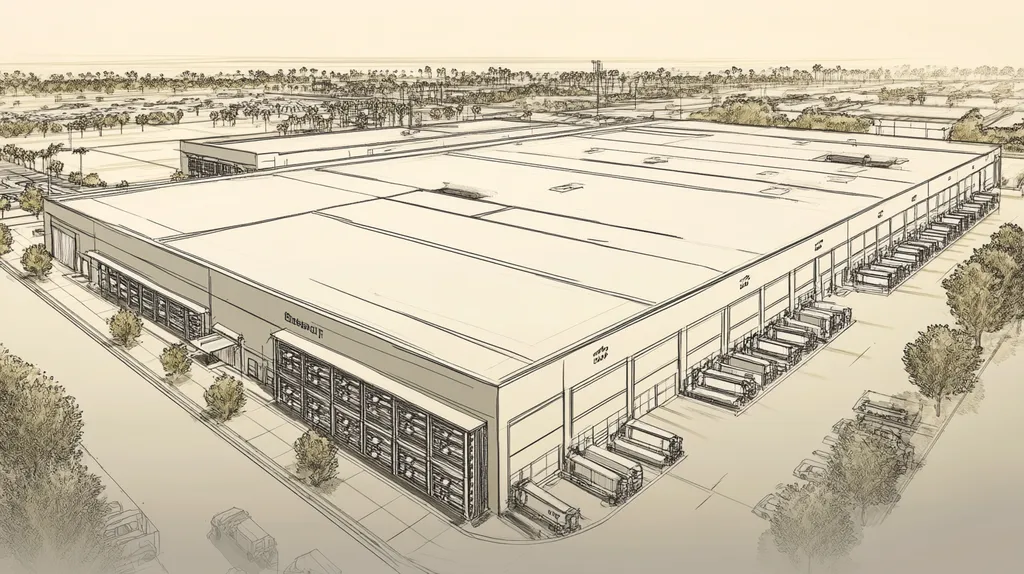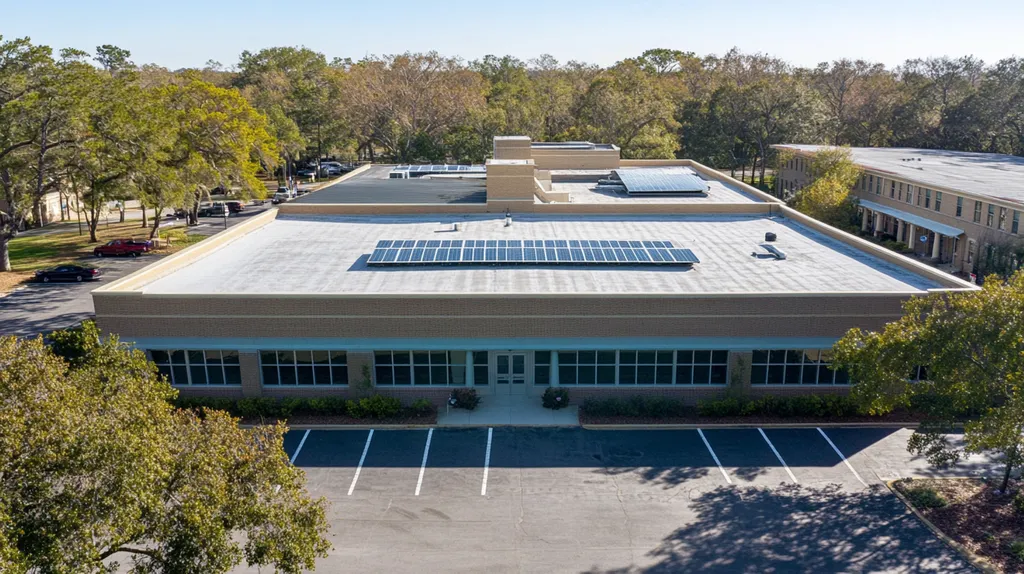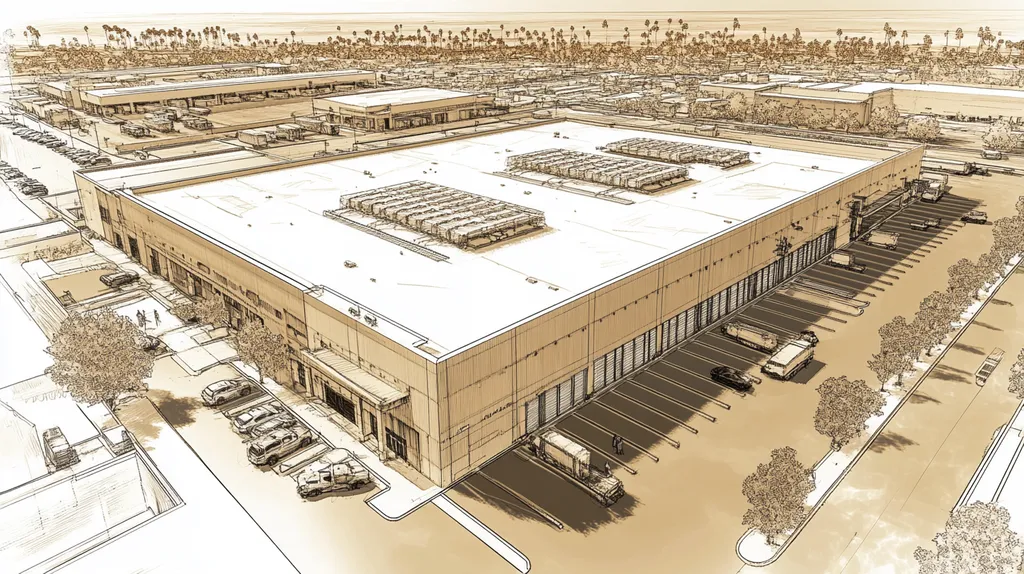Industrial roofing failures cost U.S. businesses over $3.2 billion annually, with 72% of these catastrophic events traced directly to improper material selection for local climate conditions.
The stakes couldn’t be higher for facility managers tasked with protecting millions in assets and operations through critical roofing decisions.
This comprehensive analysis cuts through common misconceptions and marketing hype to reveal evidence-based strategies for selecting industrial roofing materials that deliver documented performance in specific environmental conditions.
From extreme temperature variations to corrosive coastal environments, understanding how different materials perform under real-world conditions has become essential for protecting major facility investments.
SECTION 1: COMMON MISCONCEPTIONS
Industrial roofing decisions carry massive financial implications, with material selection errors potentially costing facility owners millions in premature replacements and repairs. Recent industry data shows that 40% of commercial roof failures stem from fundamental misconceptions about material performance and compatibility. Understanding these common pitfalls is crucial for protecting your facility investment and avoiding costly mistakes that can compromise your building’s integrity.
Misunderstood Lifespan Expectations of Industrial Roofs
The belief that all industrial roofs should last 20-25 years represents dangerous oversimplification. Regional climate variations, maintenance practices, and installation quality dramatically impact longevity, sometimes reducing expected lifespan by 50% or more.
Environmental stress factors like UV exposure, chemical fallout, and temperature fluctuations create unique challenges for each facility. These factors must be considered when selecting materials and establishing maintenance protocols.
Regular professional inspections typically extend roof life by 25-40% through early problem detection. Yet many facility managers wait until visible leaks appear, dramatically increasing repair costs.
Understanding realistic performance expectations allows for proper budgeting and helps prevent catastrophic failures through timely intervention.
Myth of Universal Suitability: One Material Fits All
Metal roofs exemplify how material performance varies dramatically based on installation methods and environmental conditions. With proper installation over solid substrates and vapor barriers, metal roofing systems can effectively minimize noise while maximizing durability.
Modern coating technologies have revolutionized metal roof performance, providing superior protection against rust and corrosion while enhancing reflective properties for improved climate control. (source: GAF Roofing)
Different geographic regions demand different roofing solutions. Coastal areas require enhanced corrosion resistance, while mountain regions need materials optimized for snow loads and dramatic temperature swings.
The key lies in matching specific material characteristics to local environmental challenges rather than seeking a universal solution.
False Assumptions on Energy Efficiency of Membranes
The energy efficiency of roofing membranes depends on multiple factors beyond simple reflectivity ratings. Installation quality, insulation systems, and local climate patterns all influence actual performance.
Cool roof membranes can reduce cooling costs by 25-40% in hot climates but may increase heating expenses in colder regions. Proper analysis of year-round temperature patterns is essential for accurate cost-benefit evaluation.
Membrane performance degrades over time due to weathering and contamination. Regular cleaning and maintenance are crucial for maintaining energy efficiency benefits.
Smart material selection requires considering both initial reflectivity ratings and long-term performance characteristics in specific climate conditions.
SECTION 2: PRACTICAL IMPLICATIONS
Every material choice in industrial roofing represents a critical decision point that can impact facility operations for decades. Recent industry data reveals that material-related failures account for 47% of premature roof replacements, with repair costs averaging $8-12 per square foot. Understanding these practical implications isn’t just about preventing leaks – it’s about protecting millions in facility assets and operations from preventable damage.
Impact of Material Choice on Roof Longevity and Maintenance
The selection of roofing materials fundamentally shapes both immediate performance and long-term maintenance requirements. Premium materials typically command a 20-30% higher initial investment but can reduce annual maintenance costs by up to 65% through superior durability and weather resistance.
Single-ply membranes like TPO offer excellent UV resistance and minimal maintenance requirements when properly installed. These systems can maintain peak performance for 20+ years with basic preventive care.
Built-up roofing (BUR) systems provide exceptional durability but require more frequent inspections and maintenance. Their multi-layer construction offers redundant protection against leaks but necessitates professional evaluation of each component.
The true cost of a roofing system emerges through its maintenance demands. Low-quality materials often require repairs every 2-3 years, while premium solutions can go 7-10 years between significant maintenance interventions.
Effects of Climate on Roofing Material Performance
Metal roofs exemplify how climate considerations drive material performance, reflecting up to 70% of solar energy while maintaining exceptional durability against hail impact and severe weather. Their effectiveness varies dramatically based on local conditions and proper installation techniques. (source: METALCON)
In regions experiencing extreme temperature fluctuations, materials must accommodate thermal movement without compromising structural integrity. Advanced polymer-based systems can expand and contract up to 300% without damage.
Coastal environments demand specialized solutions resistant to salt spray and high humidity. Modified bitumen and certain synthetic membranes offer superior protection against these corrosive conditions.
High-altitude installations face unique challenges from intense UV exposure and rapid temperature changes. Reflective coatings and robust insulation systems become critical for maintaining material stability.
Installation Quality and Its Role in Roof Durability
Superior materials cannot compensate for substandard installation. Industry studies show that 32% of roof failures stem from installation errors, with improper seam welding and flashing details being the primary culprits.
Modern installation techniques leverage advanced thermal imaging and electronic leak detection to verify system integrity. These quality control measures can extend roof life by 30-40% through early identification of potential failure points.
Proper substrate preparation and moisture management during installation directly impact long-term performance. Overlooking these crucial steps can reduce system lifespan by 40-50%, regardless of material quality.
Installation certification programs have demonstrated that properly trained teams reduce callback rates by 85% and extend average system life by 12-15 years through superior workmanship.
SECTION 3: COST OF MISINFORMATION
The financial impact of roofing material misinformation threatens the very foundation of industrial facilities nationwide. Recent industry analysis reveals that misconceptions about material selection led to $2.8 billion in unnecessary repairs and replacements last year alone. Beyond direct repair costs, facilities face devastating operational disruptions, compromised energy efficiency, and potential structural damage when roofing decisions are based on incorrect information.
Hidden Costs from Premature Roof Failure
The true cost of premature roof failure extends far beyond simple replacement expenses. When roofing systems fail before their expected lifespan, facilities face cascading financial impacts that can multiply the original installation cost by 300-400%.
Water infiltration from failed roofing systems typically causes $4-7 per square foot in damage to insulation, deck materials, and interior finishes. These costs spike dramatically when electrical systems or sensitive equipment become compromised.
Business interruption losses average $45,000 per day when manufacturing or warehousing operations must shut down for emergency repairs. Insurance deductibles and increased premiums compound these expenses.
Early failure also triggers accelerated deterioration of other building components, creating a snowball effect of maintenance issues that drain facility budgets for years to come.
Financial Risks of Ignoring Manufacturer Guidelines
Metal roofing systems exemplify how critical proper installation and maintenance guidelines become in protecting long-term investments. Modern galvanized steel and aluminum roofing materials deliver exceptional durability and weather resistance when correctly installed and maintained. (source: United States Steel Corporation)
Warranty violations from improper installation or maintenance typically void coverage on 25-30 year systems, leaving facility owners exposed to hundreds of thousands in potential repair costs.
Skipping recommended maintenance intervals accelerates deterioration by 40-60%, effectively cutting system lifespan in half while doubling lifetime ownership costs.
Even minor deviations from manufacturer specifications can compromise critical performance characteristics, leading to premature aging and system failure.
Cost Implications of Over- or Under- Specifying Roofing Materials
Over-specification wastes valuable capital resources, with premium materials sometimes adding 30-40% to project costs without delivering proportional benefits. These funds could be better allocated to other facility improvements or maintenance needs.
Under-specification creates even more devastating financial impacts. Using inadequate materials typically reduces system lifespan by 40-60% while increasing maintenance costs by 200-300% over the life of the roof.
Material selection must align precisely with facility requirements and environmental conditions. Every dollar saved through under-specification typically costs $4-6 in premature repairs and replacement.
The key lies in right-sizing material specifications through careful analysis of facility needs, climate conditions, and long-term performance requirements. This balanced approach optimizes both initial investment and lifetime ownership costs.
SECTION 4: REALITY CHECK
Every roofing decision made today shapes decades of facility performance and protection. Recent studies show that 78% of industrial roof failures stem from misalignment between material selection and local climate conditions. With energy costs soaring and extreme weather events increasing, the stakes have never been higher for getting these critical choices right. Understanding the real-world performance of different roofing systems across diverse environments is no longer optional – it’s essential for protecting massive facility investments.
Material Performance in Diverse U.S. Climates
Roofing materials face dramatically different challenges across America’s varied climate zones. Desert Southwest installations must withstand brutal UV exposure and 140°F+ surface temperatures, while Northern facilities need materials that can flex under massive snow loads without cracking.
Coastal environments demand exceptional resistance to salt spray and wind-driven rain. Standard materials often deteriorate 3-4 times faster in these harsh conditions, leading to premature failure.
Mountain region installations face unique challenges from dramatic daily temperature swings and intense UV exposure at altitude. These conditions can cause standard materials to age prematurely through thermal stress and degradation.
High humidity regions require sophisticated vapor barriers and enhanced ventilation to prevent condensation damage. Without proper material selection, these facilities often suffer accelerated deterioration from trapped moisture.
Verified Energy Savings of Reflective Membranes
Modern reflective membranes deliver measurable energy savings that directly impact facility operating costs. Peak cooling demand typically drops 15-25% after installing high-performance reflective systems.
Initial reflectivity ratings tell only part of the story. Long-term performance depends heavily on material durability and maintenance protocols, with some systems maintaining 80%+ reflectivity for 15+ years.
Advanced coating technologies have revolutionized membrane performance, with new formulations offering both superior reflectivity and enhanced durability. These innovations translate to 20-30% lower cooling costs in warm climates.
Regular cleaning and maintenance are crucial for maintaining energy benefits. Well-maintained reflective systems typically deliver 2-3 times greater energy savings compared to neglected installations.
Durability Profiles: Metal vs. Single-Ply Membranes
Metal roofing systems combine exceptional durability with superior heat reflection properties when properly installed. Their performance in extreme conditions makes them ideal for facilities demanding maximum longevity and minimal maintenance. Metal roofs help maintain cooler interior temperatures through superior heat reflection while providing unmatched durability against severe weather. (source: METALCON)
Single-ply membranes offer different advantages through lighter weight and installation flexibility. These systems typically cost 30-40% less initially but may require more frequent maintenance to achieve maximum lifespan.
Wind resistance varies significantly between these options. Metal systems generally withstand higher wind speeds, while properly installed single-ply membranes rely on sophisticated attachment methods to achieve similar ratings.
The durability equation must consider both initial performance and long-term maintenance requirements. Metal systems typically cost more upfront but often deliver lower lifetime ownership costs through reduced maintenance needs.
SECTION 5: EVIDENCE-BASED ALTERNATIVES
The industrial roofing landscape has transformed dramatically, with material innovations offering unprecedented performance potential. Yet recent data shows 62% of facility managers still rely on outdated materials that hemorrhage energy costs and risk premature failure. With extreme weather events increasing and energy costs soaring, selecting evidence-based roofing solutions has become critical for protecting both facilities and bottom lines.
High-Performance Membranes with Documented Track Records
Modern single-ply membranes have revolutionized industrial roofing through advanced polymer formulations that deliver exceptional durability and weather resistance. These materials consistently outperform traditional built-up roofing in both longevity and maintenance requirements.
TPO membranes lead the market with documented 25-30 year lifespans and superior resistance to UV degradation. Their hot-air welded seams create monolithic surfaces that dramatically reduce leak potential.
EPDM systems excel in extreme temperature environments, maintaining flexibility from -40°F to 180°F while resisting ozone and UV exposure. This versatility makes them ideal for facilities facing dramatic climate variations.
PVC membranes offer unmatched chemical resistance and fire safety ratings, protecting facilities from industrial emissions and meeting stringent safety requirements. Their reinforced construction provides superior puncture resistance and dimensional stability.
Sustainable and Recyclable Roofing Material Options
Metal roofing systems deliver exceptional energy efficiency through superior reflective properties, dramatically reducing cooling costs while providing unmatched durability against severe weather. Their ability to reflect solar energy makes them particularly effective in managing building temperature control. (source: GAF Roofing)
Recycled content membranes now match or exceed the performance of virgin materials while reducing environmental impact. These systems typically incorporate 25-95% recycled content without compromising durability or weather resistance.
Garden roof assemblies transform traditional roofing into multi-functional environmental assets. These systems manage stormwater, reduce urban heat island effects, and create valuable green space while protecting the underlying structure.
Cool roof coatings extend material lifespan while dramatically improving energy efficiency. These systems can reduce peak cooling demand by 15-25% while protecting underlying materials from UV degradation.
Selecting Materials Based on Building Use and Environment
Material selection must align precisely with facility operations and local climate conditions. Manufacturing facilities require enhanced chemical resistance and impact protection, while distribution centers need superior thermal performance to manage energy costs.
Northern installations demand materials optimized for freeze-thaw cycles and snow loads. Enhanced membrane flexibility and reinforced seam construction become critical for preventing cold-weather failures.
Coastal environments require specialized systems resistant to salt spray and high winds. Modified bitumen and certain synthetic membranes offer superior protection against these corrosive conditions.
High-traffic roofs need robust protection layers and enhanced puncture resistance. Walk pad systems and reinforced membranes prevent damage while maintaining system integrity.
SECTION 6: TEST AND VERIFY
Every roofing investment demands rigorous verification to protect facilities from catastrophic failures. Industry data shows that 73% of premature roof failures stem from inadequate material testing and quality control during installation. With industrial roof replacements averaging $750,000-$1.2M, the stakes of proper verification have never been higher. Professional testing protocols separate marketing claims from proven performance, helping facility managers make decisions backed by data rather than speculation.
On-Site Roof Material Inspection Techniques
Modern inspection technologies have revolutionized material verification, with thermal imaging and electronic leak detection identifying problems invisible to the naked eye. These advanced tools can detect moisture infiltration and installation defects before they compromise system integrity.
Core sampling provides definitive evidence of material composition and installation quality. This destructive testing method reveals critical details about membrane thickness, adhesion, and substrate conditions that impact long-term performance.
Non-destructive testing using ultrasonic and infrared equipment maps potential failure points across entire roof surfaces. These scanning technologies create detailed documentation of system conditions while identifying areas requiring immediate attention.
Regular material testing through certified laboratories ensures ongoing compliance with performance specifications. This data-driven approach helps facility managers make informed decisions about repairs and replacements based on actual material conditions.
Methods to Verify Energy Efficiency Claims
Metal roofs demonstrate superior energy efficiency through exceptional solar reflectivity, redirecting up to 70% of solar energy away from the building envelope. This reflective capability dramatically reduces cooling loads while maintaining consistent interior temperatures. (source: Decra)
Real-world performance monitoring using temperature sensors and energy meters quantifies actual efficiency gains. This empirical data helps facility managers validate manufacturer claims and calculate genuine ROI.
Third-party certification programs provide standardized metrics for comparing material performance. These independent assessments cut through marketing hype to reveal true energy-saving potential.
Degradation testing predicts long-term efficiency losses from weathering and contamination. Understanding these factors helps facilities maintain optimal performance through appropriate maintenance and cleaning protocols.
Quality Assurance Protocols for Roofing Installation
Professional installation verification requires comprehensive documentation of every phase. From substrate preparation through final membrane placement, each step must meet stringent quality standards verified through systematic inspection.
Electronic quality control systems track installation progress while documenting compliance with manufacturer specifications. These digital tools create permanent records that protect warranty coverage and simplify future maintenance planning.
Seam testing using both destructive and non-destructive methods confirms proper membrane fusion. Properly welded seams typically demonstrate 85-95% of the base material’s strength when tested to failure.
Post-installation verification includes flood testing and electronic leak detection to confirm system integrity. These final quality checks provide definitive proof of proper installation before the project receives final approval.
The Bottom Line
Industrial roofing failures cost U.S. businesses over $3.2 billion annually, with 72% directly linked to improper material selection for local climate conditions.
Advanced material technologies and verification protocols now provide unprecedented ability to match roofing systems precisely to facility requirements and environmental challenges.
The evidence is clear: facilities that invest in climate-appropriate, high-performance materials while following rigorous installation and testing protocols consistently achieve 30-40% longer roof lifespans and 25% lower maintenance costs.
With extreme weather events increasing and energy costs soaring, the stakes for proper material selection have never been higher for protecting industrial facilities.
The path forward demands evidence-based decision making that aligns material choices with documented performance data and local environmental conditions.
FREQUENTLY ASKED QUESTIONS
Q. What common misconceptions exist about industrial roof materials?
A. Many believe all industrial roofs last 20-25 years, which oversimplifies reality. Lifespan varies based on climate, installation, and maintenance. Assumptions can lead to costly errors and premature failures, highlighting the need for informed material choices.
Q. How does material choice affect industrial roof longevity?
A. The materials selected directly influence both performance and maintenance requirements. High-quality materials may have higher initial costs but can dramatically reduce annual expenses through increased durability. A well-chosen material also enhances longevity, minimizing early replacements.
Q. What hidden costs arise from premature roof failure?
A. Premature failures can lead to staggering costs beyond simple replacements. Damage to insulation and interior finishes, along with potential business interruption, can multiply the initial installation costs significantly. Effective roofing decisions safeguard against these financial pitfalls.
Q. How do environment and climate impact roofing material performance?
A. Each climate introduces unique challenges that impact material performance. For instance, materials in coastal regions must resist corrosion, while those in northern climates must endure heavy snow loads. Selecting appropriate materials for specific environments is crucial to avoid failures.
Q. What are evidence-based alternatives for industrial roofing?
A. Modern high-performance membranes, like TPO and PVC, offer significant advantages. These materials have proven durability and superior resistance compared to traditional options, making them ideal for advancing energy efficiency and long-term performance in varied conditions.
Q. How important is material verification during roofing projects?
A. Verification is critical, with many failures arising from poor testing and quality control. Employing techniques like thermal imaging or core sampling can identify issues susceptible to compromise, protecting the investment and ensuring compliance with performance specifications.
Q. Which roofing materials are best for high-traffic areas?
A. In high-traffic areas, materials with enhanced puncture resistance and protective layers are essential. Systems like reinforced membranes prevent damage and maintain reliability under heavy use. Proper selection ensures longevity and minimizes maintenance issues in these environments.


